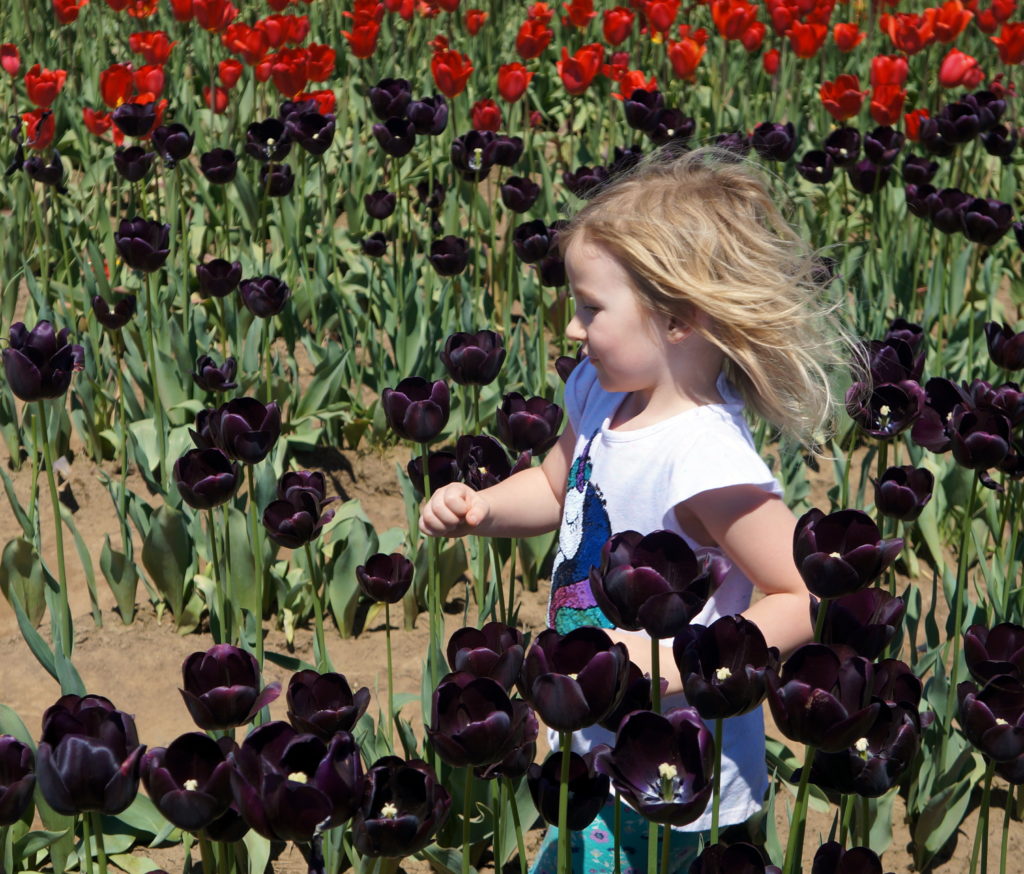Feastday: December 12
We do not do this feast justice in our house, even though we celebrate it every year. Our parish has a large Spanish-speaking community and this year we’re going to celebrate with them. I hope to learn more and report back!
stories and musings of a life-long conversion
We do not do this feast justice in our house, even though we celebrate it every year. Our parish has a large Spanish-speaking community and this year we’re going to celebrate with them. I hope to learn more and report back!
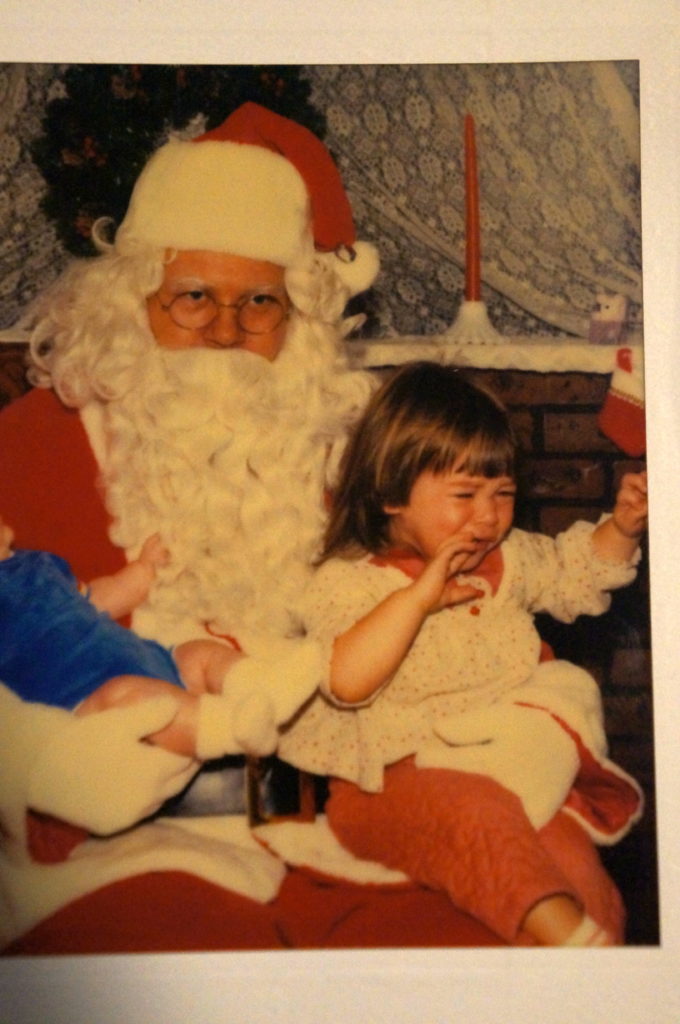
I, like most kids, grew up with the Santa Claus myth. It’s a rite of passage in my family to have a photo with Santa while screaming in terror. I never really believed that Santa Claus came down the chimney and put presents under the tree, but I sure wanted to. My mom put “from Santa” on our presents for a long time, but I knew it was a gag. I loved fairytales, though, and to me Santa was a fairytale. Not real? No problem, neither are flying dragons or life-giving first kisses, so I could deal with the Santa myth and not feel like my childhood was falling out from beneath me. But my husband and I knew we didn’t want to push the Santa thing when we had kids. Especially once we knew the real story. I’m not saying it’s bad to do the Santa-thing, I think it’s totally a parental choice, but even if you do the Santa-thing, introducing kids to the real St. Nicholas is magical and {bonus} true.
Well, most of it’s true. Like a lot of saint stories, pieces of it have become myth and legend. But miracles can easily begin to sound mythical, so who’s to say St. Nicholas didn’t bring back to life three boys who had been boiled for stew by an evil cannibal? Or bi-located and saved sailors from shipwreck? It could happen.
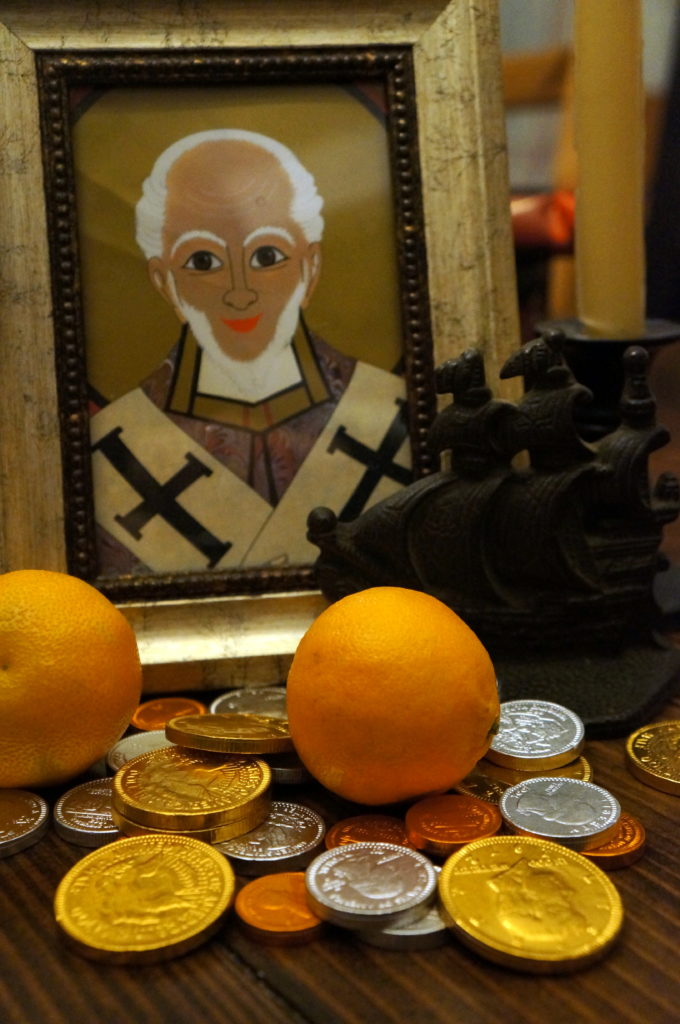
We know for sure that St. Nicholas was the Bishop of Myra in the 3rd/4th centuries, and because of the many miracles attributed to him even during his lifetime, is often called St. Nicholas the Wonder-worker. He was (effectively) Greek and claims a large number of devotees in the eastern church. I didn’t hear about him until I was Catholic, and though I don’t remember specific families or conversations, somehow I gradually learned about the various traditions surrounding his feast day. The first year we celebrated St. Nick day, our two oldest daughters who were then younger than three, left their shoes outside their door and we put little chocolates in them. The next year, I bought them shoes and put gifts in those, then eventually we arrived at an official Family Tradition: we open stockings in the morning of St. Nick’s day, then have a Greek dinner.
These are stockings I made just for St. Nick’s Day out of red ticking and linen, and– this is important– they are small so they look happily full without my having to break the bank on gifts. But you could easily buy simple, cheap red fake-velvet stockings and accomplish the same thing.
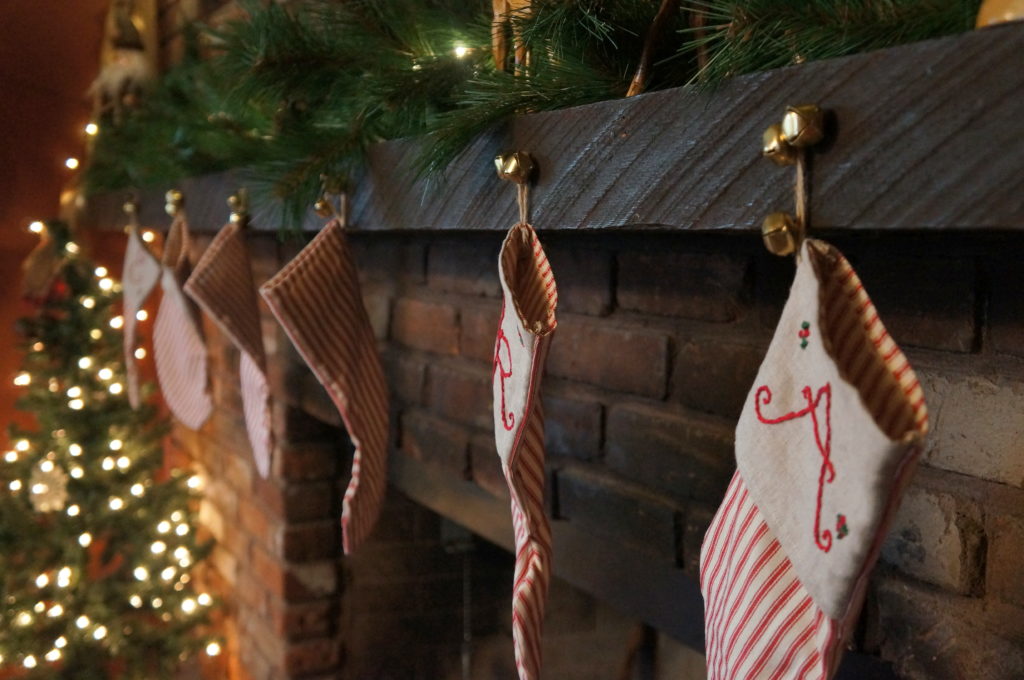
What goes in the stockings?
For the feasting, which is very important since Advent is technically a time of penance and feasts are a nice breather, I make Greek roast, Greek potatoes (which is basically olive oil, salt, and lemon), and some kind of vegetable. For dessert, The Best Part, we vary it up. Some years we make Russian tea cakes, or Chocolate-Peppermint cake, and I think this year I’ll try iced Gingerbread.
St. Nicholas is the patron saint of children, which I’m sure is one way the whole Santa Claus myth began. Ultimately, the story of Santa Claus giving out gifts to over-toyed children came from the story of a real person whose love for Jesus Christ led him to love, serve, protect and heal the poor and helpless. Some year I’d like to make that a part of our feast, too.
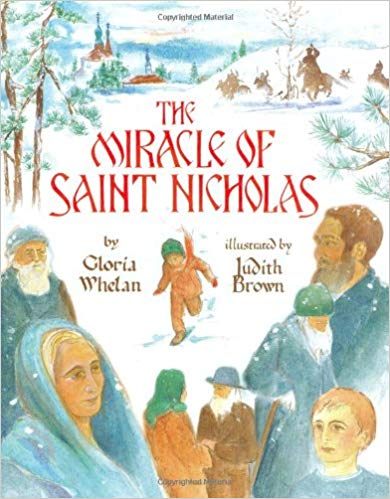
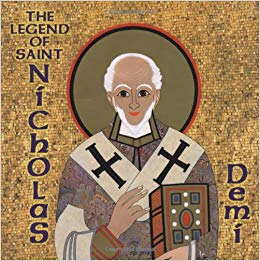
PThese two books about St. Nicholas are absolute treasures:
Greek seasoning from Greece is the best, but this is a worthy substitute (and has been tested on real life Greeks).
From the viewpoint of the donkey, we learn about the symbols of Mary as he imagines carrying each on his back: the city, the ship, the fountain, the rose. It’s a good conversation-starter with older children, and good for younger children to let the imagery sink into their minds and hearts.
Demi has written and illustrated several beautiful books, a few about saints, but this was the first one we purchased. Her style is reminiscent of Byzantine iconography, which fits the story of St. Nicholas perfectly. She includes all the stories of the real St. Nicholas, even when the boys get boiled and brought back to life, so it might need to be read under supervision. But one thing I appreciate is at the end she has a page of illustrated Santas, which puts the whole St. Nicholas/Santa Claus thing into perspective for kids.
So this book makes me cry. Every time I read it. It’s about a small village in Russia that is in spiritual hiding. That’s all I can tell you. It’s not really about St. Nicholas, but he’s important to the story.
This story takes place in the Nordic countries where the feast of St. Lucia is uniquely celebrated. It begins with a family preparing for the feast, but later explains the real story of the martyr St. Lucy. I love that the reader learns both about the traditions established up north, and about the saint.
We have many books illustrated by Gennady Spirin. Her art is a visual feast of detail and color. The text of this book is simply the traditional song, We Three Kings, but each verse has its own elaborate illustration.
Anything by Tomie de Paolo is worth reading until the binding wears thin. Several of his books I’ve had to buy two copies of as they’ve been beat up over the years. He has a few Christmas books, but Legend of the Poinsettia is a lovely, sweet story that takes place in Mexico. Another one of de Paola’s Christmas books that our younger kids love is The Friendly Beasts.
St. Jean de Brebeuf, a Jesuit missionary who lived and died among the Huron tribe in eastern North America, told the Christmas story to these first peoples in a culturally appropriate way. It has a beautiful tune when sung, and the sheet music is included in the back of the book.
Taken from the Gospels, the text is simply the Christmas narrative, but with classic paintings by Gossaert, Reni, Boticelli, and many more.
Jan Brett is a favorite in our house; we love the detailed, but folky style. There are so many great wintry Brett books, but this one has always been a favorite: a retelling of Goldie Locks and the Three Bears.
This book is a solid re-telling of Tchaikovsky’s ballet with pretty illustrations.
And last, but not least, this book is a beautiful pop-up sort of book. It’s not for little hands, but it’s still worth having. It tells the Christmas story. We just tie ours permanently open and it sits visible on a shelf in a star-shape for the kids to look at.
Our hearts must be keenly alert for opportunities in our own little corners of daily life. May we stand in this world, not as people in hiding, but as those who help prepare the way of the only-begotten Son of God.
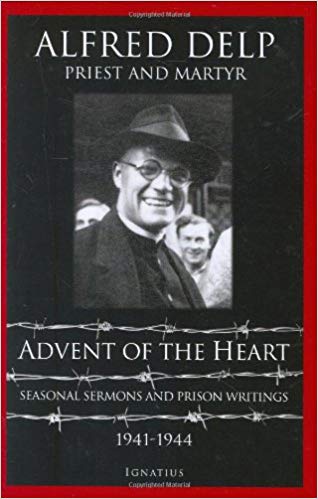
On February 2, 1945, three men were hanged within Tegel Prison in Munich on grounds of treason. Fr. Alfred Delp was one of them. He had been convicted and tried for preaching against the Nazi regime. During his time in prison, he wrote reflections and sermons on little bits of paper, which were providentially smuggled out. Those reflections were gathered along with his previous sermons during Advent and published in a collection entitled Advent of the Heart.
The first time I read this book, it opened my eyes to the meaning and purpose of Advent. I’ve come back to it every year, and every year I find something new to meditate upon.
Fr. Delp’s fortitude and courage is communicated through his preaching. He writes about being shaken awake in Advent, about spending one’s life as a candle does for light. He writes about figures in Advent, like St. John the Baptist and the Blessed Mother. Knowing the situation he was in— of close monitoring by the Gestapo as a priest, followed by imprisonment, torture, and death— at the time he wrote these insights, adds more gravitas to his words, “All of life is Advent.”
The best way I can think to introduce this book to you would be to quote from Houselander directly:
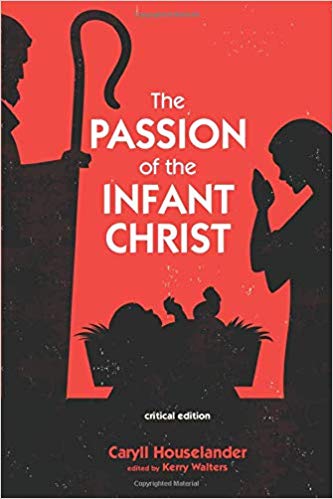
This book is mainly concerned with Christ’s infancy and childhood, and His infancy and childhood in us, not because this is the only way in which He can be in us, for that it certainly is not, but because, however else Christ is manifest in our souls, His life in them must start by being simply the infant life, the small, miraculously helpless life trusted to them to foster, that it may grow.
In Houselander’s unique style, she relates theological truths to life experiences, patterns in nature, and broad social issues. This book reminds me in its style of Way of the Cross in how she reveals the face of Christ in different people of different circumstances in life. It draws the reader out of themselves and asks them to re-examine their life in relation to others, but mainly in the way that “others” should all be the Christ-child to us.
Disclaimer: I haven’t read this book YET, but my husband has and, though you don’t know him, I do and I tell you he’s a good resource for books. It’s split into two halves: the first for Advent, the second for Lent.
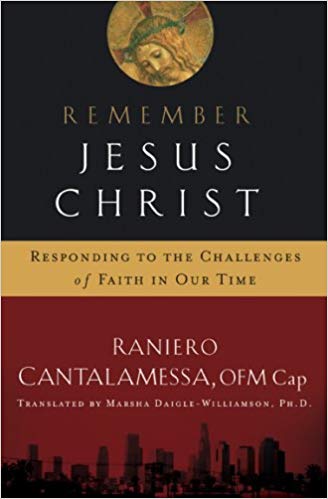
In order to bring people to Christ today, the Church needs to proclaim as simply and succinctly as the Apostles did, that “Jesus Christ is Lord!”
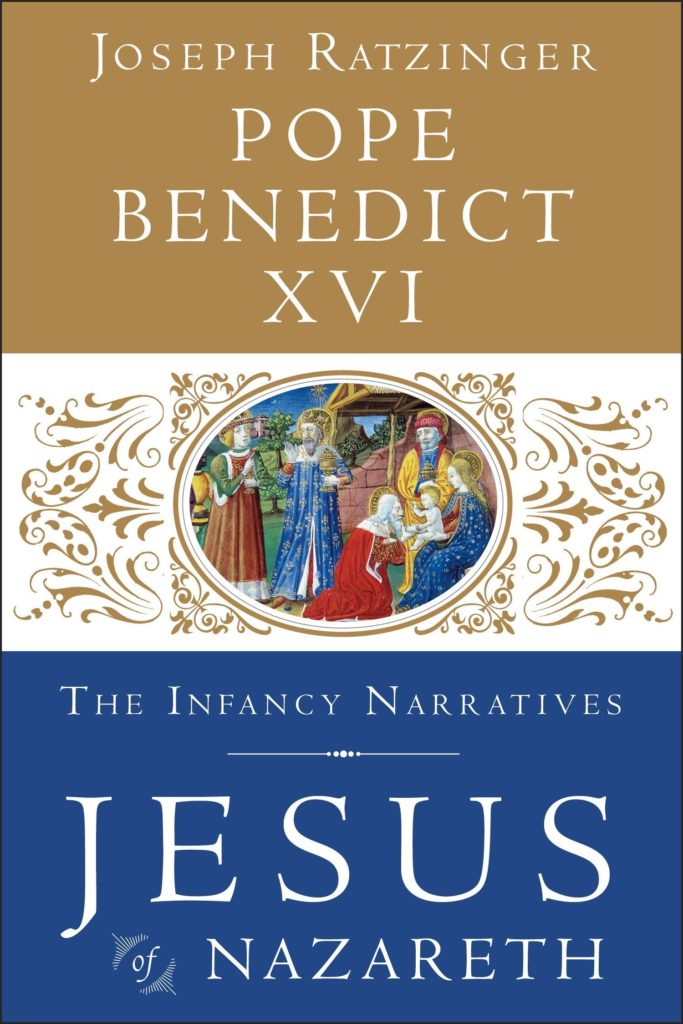
What I enjoy about this book are all the particulars– the scholarly details that lead to contemplation. Pope Benedict writes extensively on the genealogy of Jesus and what it means, the social and historical context of Roman-occupied Judea, while jumping to and from each Gospel account. I personally love when he compares in detail the annunciation of John the Baptist’s conception to Zechariah, and the annunciation of Christ to Mary.
Also, consider for Advent reading the sections pertaining to the Annunciation and Christ’s birth in Romano Guardini’s The Lord, Fulton Sheen’s Life of Christ, and Adrienne von Speyr’s Handmaid of the Lord.
Advent is a heart that is awake and ready.
Fr. Alfred Delp
Advent is a season of preparation, but in these last few days preceding Advent, I am in a period of preparing for the preparation by uncovering boxes in the garage that house the Advent wreath, candles, Jesse Tree and ornaments, books, etc. It’s much like that excitement I felt as a child in preparing for Christmas Eve after winter break had begun and Christmas seemed palpably near. The whole season is different for me now as an adult, and as a Catholic, but that stirring of the heart in anticipation of something mysterious and beautiful is familiar and comforting. Advent is my favorite season, even more so than Christmas.
I remember somewhere in adolescence when the magic of Christmas had waned. It was depressing. I tried to drum up the feelings of Christmas, whatever that means, the kind of sentimental nonsense I absorbed from department stores and Christmas movies, or something. But after entrenching myself in the liturgical year as a Catholic, the magical quality of Christmas was restored, but not just as a sense of wonder, but as reverence, a holy awe at the prophecies of Christ’s coming and the mystery of the Incarnation. Suddenly, life comes to a point; the purpose of everything is narrowed down to an incomprehensible moment when God becomes man. Yet, it’s not just about a sweet little God-man baby, but about the final coming of Christ. We see that our whole existence is one great Advent, a brief preparation for uniting with God.
Over the years, we’ve developed family traditions during Advent. We’ve added on, stolen ideas from other families, altered them, and every year is a little bit different. But our kids have come to depend on these little feasts and practices to make the waiting bearable:
My aim in describing what we do as a family is to demonstrate that it doesn’t need to be perfect. It really can be thrown together. I’ve been surprised that scrambling for a little celebration one year is expected the following year as an established tradition. These little traditions provide a drumbeat on the march toward Bethlehem.
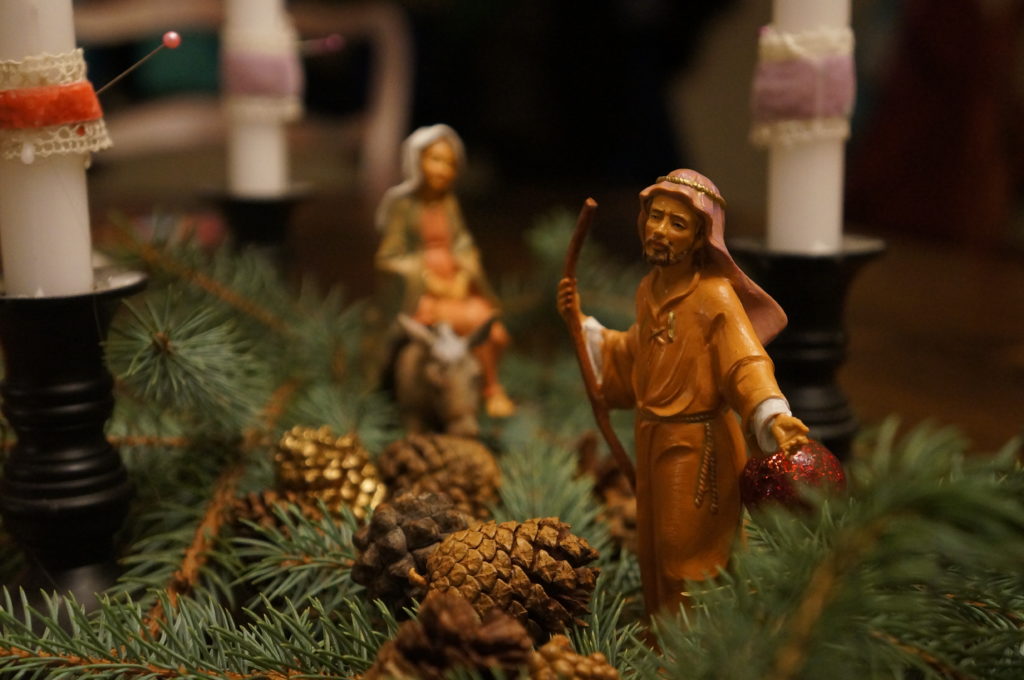

I had a dream the other night that I was at an audition. Right before my turn, I had to watch a girl audition before me. And she was amazing. I mean, this girl was tap-dancing, singing, AND playing the ukulele (and she bore a strong resemblance to Ann Miller). In my dream, I wanted to back out of the audition, but an even more pervasive feeling was smallness. I felt like I was growing more invisible and inconsequential by the second.
I’ve had stress-theater dreams before where someone tells me I’m in a show and I have to go on stage, but I have none of the lines memorized. Or stress-teacher dreams when I show up at school without a shirt on, or stress-college dreams when I find out I still need five credits to graduate. Or even stress-marriage dreams when I realize we’re still not married even though we have six kids together. But this wasn’t like that. I kind of laughed to myself about it all morning—I mean, that’s pretty funny, a tap-dancing, singing, ukulele-playing Ann Miller—but then I realized: I know where that came from…
I recently felt intimidated by another woman, and it took me by surprise. It’s been a long time since I felt small and inconsequential in someone’s presence. Humbled, sure. Inspired, yes. But suddenly self-conscious and uncomfortable about being me? It’s been awhile. While talking to her, I found myself wondering, “I bet she has a ‘beauty regimen’, whatever that is. I’ve never had a ‘beauty regimen’. Should I start having a ‘beauty regimen’? Buy creams or something?” I had a flash-memory of something I had passed in the store, some kind of skin-boosting de-wrinkling face mask that maybe I should have bought after all.
Then, by an act of the Holy Spirit I’m sure, I realized I was objectifying this person. I was assessing this girl like a virus scanner, looking for ways she was all noise and no substance, only because I felt small in her presence. This is the embryonic state of The Mean Girl. From here, it can only get so much worse. I snapped out of it, hoping I hadn’t caused palpable tension in the room with my laser-beam nasty-probe. Ideally, I wouldn’t have had to enter into the equation at all, except to offer my hand and heart to someone new.

As women, why do we do this? Why do we compare ourselves?
Ironically, I’ve been advising my daughters through similar things. Growing up in public school really was like the scene in Mean Girls when the students are acting like animals in the wild, either on the prowl, on the defensive, or tearing someone to pieces. That was definitely the subtext of my childhood education. When girls meet someone they are intimidated by, they either avoid them, grovel, or become their best friend just to keep them close. I thought by homeschooling my children, they wouldn’t encounter that kind of behavior. While they’re not immersed in it, I’m actually really thankful they get glimpses of it in social situations. It’s interesting to see how they react, how it stabs them to the quick, but how easy it is to fall prey to petty behavior. I’ve seen them leave a social situation and, as though having been in a girl-world-trance, break out of it with shock and confusion about how they acted, or at having been injured by another girl’s behavior. Why and how did that happen? their bewildered faces say. Because you’re a lady-human, I reply. And we have to consciously choose charity every moment of our lives.
St. Teresa Benedicta of the Cross famously wrote, “The world doesn’t need what women have, it needs what women are.” We nurture and cultivate life, we care for and draw out the individual, we seek out the heart and connect it to all aspects of living. This is certainly true in the reverse: the malice we are capable of on a personal, intimate level can be destructive. It’s the kind of harm that breaks down a person piece by piece from the inside, chipping away little by little. But when we, as women, use our personal insight to encourage and build up a person, the result is truly remarkable. Instead of reading another woman like a Pinterest-board and seeing all the things we aren’t or don’t have, we can thank God that amazing person exists in the world. (Because, honestly, the world would undoubtedly be a better place with more tap-dancing, singing, ukulele-playing Ann Millers.)
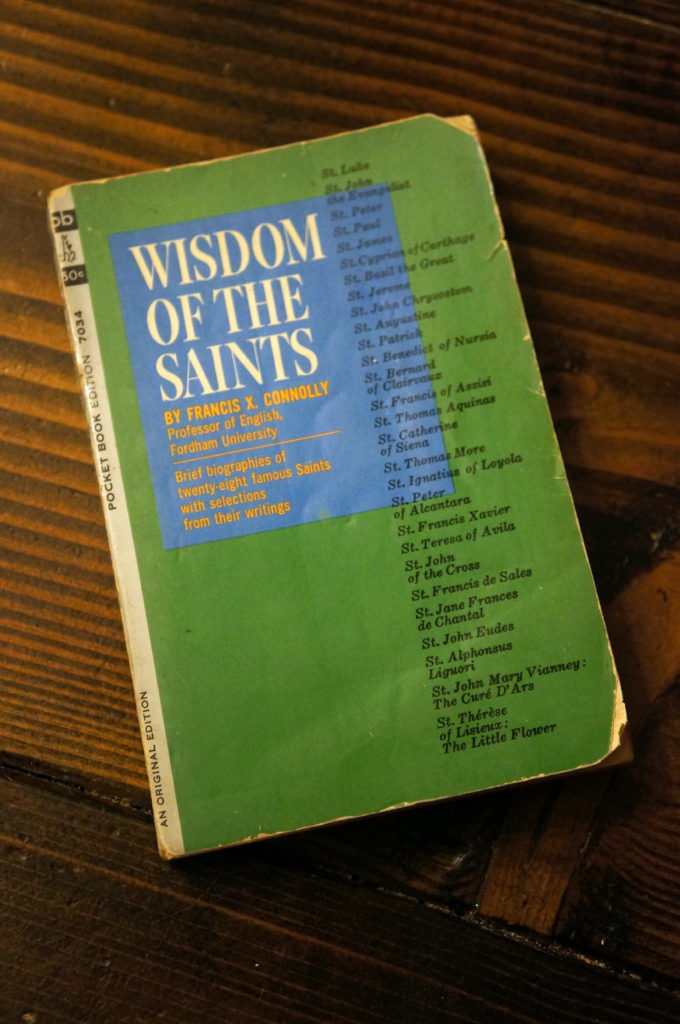
At a garage sale sometime around the age of 16, I bought a little green book called Wisdom of the Saints. I can’t say why I bought it at the time, because at the same garage sale I bought a print of a painting of Venice that wasn’t particularly good, and the book Coffee, Tea, or Me. But Catholicism had recently entered into my consciousness. I had a Catholic boyfriend who was in the process of re-discovering his Faith; I had just toured the Iberian Peninsula with my grandparents and fresh memories of cathedrals and Fátima were percolating quietly in the recesses of my heart. So for some pocket change, I bought this little book. It was like a saint appetizer plate, including brief bios and writing samples of some of the greats. I read a little here and there—my James Dean bookmark still holds my place.
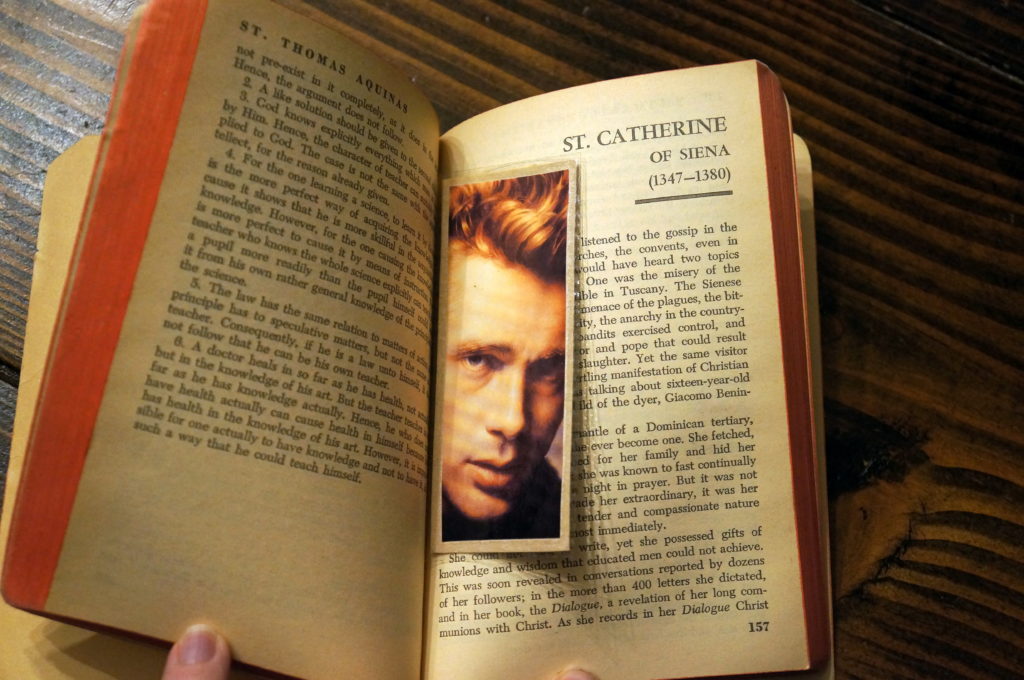
At the time, the whole “saints” thing was one of those medieval Catholic inventions I had heard people talk about, things I knew we were supposed to snuff at as post-Reformation, American Christian people. We were smarter now, and knew it was all poppycock. Once you’re dead, you’re dead. Though, I did believe in an after-life, that souls went to either Heaven or Hell, which meant our souls kept on living in some kind of way. But Heaven was like a distant place, the “better place” which God lit up with his light and love. I think I pictured it like a drug-less Woodstock where everyone was blissfully happy and hugging each other. People I loved who had died had gone there and we would see them someday, but were for now off the radar, sealed away.
For me growing up, the only guarantee in the invisible, spiritual world was God and the angels, as well as the devil and demons. It made logical sense to me that if I really believed in the eternal-ness of our souls, just as I asked people to pray for me in the here and now, then I could ask the living souls to pray for me— those who had died, but whom death had not conquered through Christ’s salvific work on the Cross. Intellectually, I understood this. But the actual practice of it would take some time (and a little gumption). I could pick up a book like Wisdom of the Saints and appreciate the wisdom. But anything beyond that bordered the crazy.
The funny thing is, it seemed like certain saints started choosing me. I heard this from other people through the years, how it is true for them. Now that I’ve had children, I absolutely believe this to be true. For me, St. Faustina Kowalska and St. Thérèse of Lisieux were the two spiritual power-houses who caught my attention at first. I write more about that [here] and [here].
The communion of the saints changed the way I understood Heaven, and in so doing, how I related to the eternal on a daily basis. Heaven became a part of my life in the present, something not just to long for but also to experience here on earth. The communion of the saints is tied into the Mass: with the angels and saints we proclaim, “Holy, holy, holy!” While they kneel at the throne of God, we kneel to our humble Lord and Savior come to us in the form of bread.
When I started having children, I was at a loss as to how to teach them a number of Catholic things, but the Saints was something I was really eager to share with them. I’m so thankful they posses an awareness of this greater Christian family. Though we haven’t always been consistent, we try to celebrate all of their feast days (or name days). As they get older and are confirmed, they can choose their own feast. My eldest took Francis of Assisi as her special patron at her Confirmation, so now she considers October 4 her feast day. My second-eldest has a few namesakes, but has chosen St. Faustina’s feast most recently. Celebrating their feast day can be as simple as an acknowledgement, or they might get the day off from school (we home-school), sometimes we’ll have a special treat or something like that.
Through the years, at times during night prayer, each of the kids could pick a saint from whom to ask for prayers as part of a family-wide litany. As each of them gets older, I’m surprised sometimes by the saints they call on. Sometimes I know why that particular saint is on their mind, whether they just read about them in school, or they had a recent feast day, but there are times when it’s out of the blue to me, which is a lovely reminder that they’re on their own journey of faith. Last year I wrote up a family Litany of Saints to pray on All Saint’s day, November 1. It was alarmingly long, and really powerful to pray together.
As more people close to me have died, Heaven begins to feel nearer. Through childbirth, Heaven feels nearer. And the reality is, the veil that separates us from the eternal is thin. I could go through life without knowing about the saints, but I don’t know why I would. There is strength in numbers. And I need encouragement and guidance from my brothers and sisters here with me in this life, as well as those who have joyfully finished the race.
I’m sitting in our hobbit-ranch home on the edge of a small Oregon town which is bordered by farms, and beyond that the Chehalem mountains which are aglow this time of year with autumn hues and evergreens. Up to this moment today, the sky has been a clear, glorious blue, which makes the large maple outside our window look like a sacred flame. Rather suddenly the weather has turned. There are bursts of wind, from which there is no shield, coming off of the flat farmland; the sky is a bright gray, like one large flat rain cloud. I’ve opened the window just a little, even though the air is bitingly cold, because I love the sound of the wind in the trees. It’s one of those moments that touches all human senses and places me in the realm of the beyond, remembering God as Creator, and myself at the mercy of His touch.
In just a half-hour of wind, the giant red maple is a third barer than it was earlier today. I feel a kinship with that tree, as it gets tossed about in this unforgiving weather. It reminds me of a conversation I had years ago. I had a smoking buddy in college. After studying all afternoon and into the evening, we’d meet up and walk around the small college town talking about everything and nothing, smoking our cigarettes. We both had ghosts in our pasts, and we never talked about any of that—we kept conversation pretty light and nonsensical, and yet a lot was said in all that was unsaid. A couple times I tried to bring up something real—like faith or love—and I knew right away by his body language that he didn’t want to go there. So I quietly agreed to this arrangement, like smoking without inhaling.
It was the end of fall and the ground was littered with fall muck—the muddy mixture of rotting leaves and pine needles and standing rain water. The trees were mostly bare. I looked down at my shoes a lot during those walks, and I remember seeing the wet leaves matted to my boots. He asked me, “If you could be a tree, what would you be—coniferous or deciduous?” He half-smirked, as though he knew it was a silly question. It was the kind of question one might be asked the first day of an orientation, a dumb get-to-know-you question; it’s ridiculous, but still reveals something about the person’s character.
“Deciduous,” I replied, without pausing. I’d thought of it before. I’d rather be beautiful and glorious for a short season, than the same for all time. At 20, that’s all I’d been doing my whole life, changing and moving and growing. I was intimidated by constancy. Having a career sounded daunting, marriage sounded terrifying, living in the same town for the rest of my life sounded like a prison sentence. I was thrilled and delighted by changeable things, and everything that celebrated it—fashion, art, film, etc—in the way a moth is to a flame, stupidly and thoughtlessly drawn. Of course, that kind of changeableness is exhausting and ultimately unfulfilling.
It strikes me as ironic, as I sit here, looking out at the calm after the short-lived storm, that though my life has been quite different than what I imagined at 20, I have in fact lived a deciduous life. It’s been ever-changing and shifting, but not from my own choosing. Everything about me—shape, color, fruitfulness, bareness—has shifted and moved from season to season. I feel more like a weathered tree, like the maple outside with the tips of its branches exposed. I’m only 37, but I am a bit worn and weary. I often think of Bilbo Baggins describing his weariness as “butter scraped over too much bread”. Exactly. At 20, when I imagined my “deciduous” life, I imagined it changing with adventure, travel, relationships, artistic endeavors; in short, a selfish existence where I called the shots, marked the seasons, changed when I willed. Of course, that never would have come to pass, even if I hadn’t had a conversion, hadn’t met someone that anchored me and helped me be a better human, hadn’t promptly started having babies and pouring myself out. Even if all that hadn’t happened, I would have eventually grown disillusioned, or frustrated with the many changes out of my control, even in a supposed self-driven life.
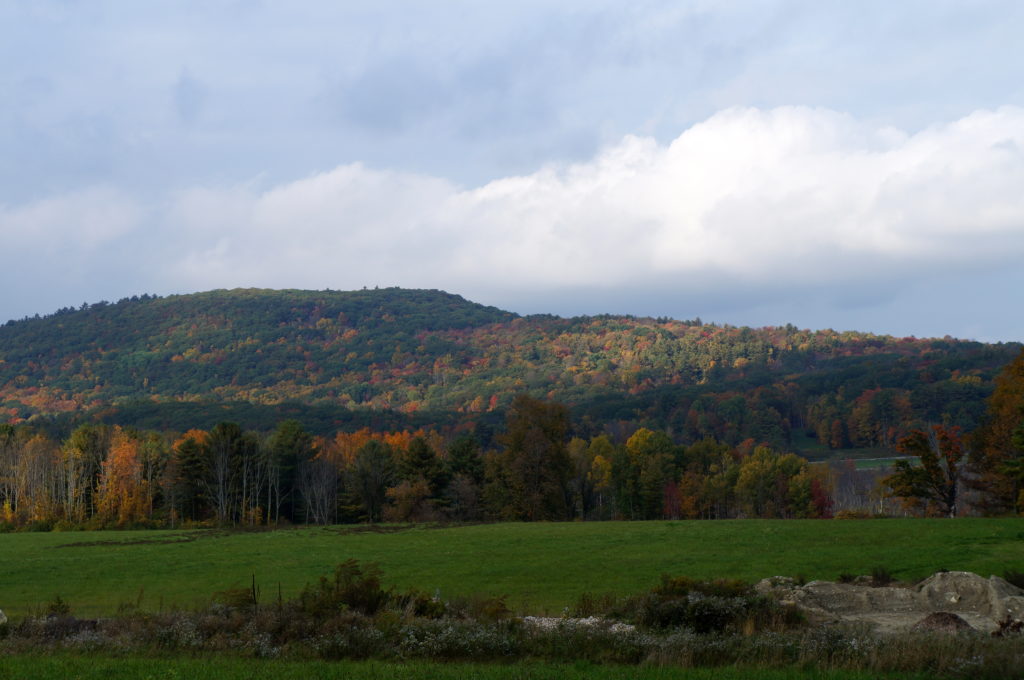
When I was 20, I didn’t really think about the tree’s seasonable bareness, just its ravishing beauty. But of course now, I see the cycle in its wholeness. I know this period I’m in of child-rearing and successive tasks is just a season. Another season is coming, with its own beauty and hardships. Even though I am weary and feel a bit physically ransacked, I have no regrets—this is the best way I can think of to spend my life. If we as humans are intended to spend ourselves, it’s best to embrace the deciduous nature of human existence; to embrace the seasons with trust in the Creator.
I am with you, for I have called you by name; your labor is not in vain.
By January of 2000, I was nearly 18, a senior in high school, and my trajectory towards the Catholic Church was pretty sure and straight. My exterior life—friends, school, the rapidly approaching future—was suspended in mid-air, like an alternate reality carrying on in a thought bubble, while interiorly I was going through an inexpressible alteration. I was sneaking to daily Mass either before school or in between classes. The weekday stillness of St. Joseph’s, St. James’s, and the Grotto were my sanctuaries in every sense of the word.
One morning as I was heading to daily Mass in my ’85 Honda Accord named Bogie (after Humphrey Bogart who, like my Honda, was old and raspy, but so cool), I turned into the parking lot to see more than the usual seven to ten cars. The lot was overflowing. I rolled down my window to ask a parking attendant what was going on.
“St. Thérèse’s relics are here,” he said. I nodded like I knew what he was talking about, but inside I was reeling from the words “saint” and “relics”, having visions of fingernail clippings and femurs.
Why did I go in to Mass that day, then? I do not know. But I did. And in my pinstripe overalls, no less. Why, when I saw the TV cameras and men in funny hats and sabers, did I not turn around and leave? I do not know. Though the sanctuary was over-full, I squeezed by the anxious families in the foyer, slipped through the glass doors, and took a tiny spot alongside the wall. In the front of the church, at the foot of the altar, was a wooden casement surrounded by what I could only assume was bullet-proof glass. It was all very strange. Compelling, but strange.
The Mass began and I was quickly lost, as this was slightly different from truncated daily Mass. After I fumbled through the Gloria and the Nicene Creed, an older, handsome gentleman in front of me with dark, thinning hair and glasses turned around and said, “You don’t know what you’re doing, do you?” I answered, “No.” With a gentle smile, he said, “My name is Conchi, short for Concepción.” He pulled out a missal, stood beside me, and tried to explain what he could in a whisper. The lady in front of us looked back with a mean glare to hush us at one point, but Conchi ignored her and faithfully coached me through the Mass.
People were starting to file towards the relics. He told me what to do—to kiss my fingers, touch the casement, then make the sign of the Cross. I eyed the TV cameras in the back, hoping I didn’t make it on the news in my pinstripe overalls, then my secret of going to Mass would be out—and not just going to Mass, but doing whatever I was about to do with those relics. I did what Conchi said, mechanically, feeling like an imposter.
It came time for Communion and Conchi asked me if I wanted to go up for a blessing. In all my attendances of daily Mass, I had never gone up for a blessing, but had remained kneeling until it was finished. He told me to cross my arms over my chest, so I did.
I was starting to worry about the time at this point, concerned I’d be late for class since daily Mass usually didn’t take this long. As soon as it was over, I turned to thank Conchi, but he was gone. As I maneuvered my way through the crowd and out of the church, I kept an eye out for him, but I never saw him again.
As I walked by the St. Joseph statue outside, a strange awareness caught me by surprise: I had a sense that there was something over me, like a thin veil covering my face, a substance that I could see through, but that was protecting me somehow, hiding me. I wondered at the time if this was what “grace” felt like, that thing I had read a little about, that thing the early Church Fathers talked about with the Sacraments. Not the vague—though wonderful—grace I had learned about as a Protestant, the over-arching power that Jesus imparts to reach out to us and save us. This was different; it was an actual, tangible something.
The rest of the day passed in a fog; again I felt like I was going through the motions of my daily life: school, friends, play rehearsal, family, while this great secret tectonic shift was happening in the depths of my being.
When I got home late that night, I remembered a little green, musty book I had bought at a garage sale a couple years before, Wisdom of the Saints. I leafed through it and found the last chapter about St. Thérèse of Lisieux, which included an excerpt from Story of A Soul. As I read through this tiny piece of her writing, I was shocked by the amount of Scripture she quoted from memory, as though it flowed out of her heart as purely and freely as her own words. I cannot say what struck me most about St. Thérèse; I don’t remember feeling an immediate kinship with her. I was, however, struck by how she was called to the religious life so young, yet had confidence in God’s loving plan for her.
What I didn’t know at the time was how this little saint would become a companion through my life, a novice-mistress of sorts for my own spiritual life.
The other day, my four-year-old daughter heard the word “festival” and grew very excited. She said, “Do you remember the Tulip Festival?!! That was SO FUN!”
Do I remember the Tulip Festival? Yes. Yes, do I ever. It was the day my daughter turned Verruca-Salt on me. This is how I remember it:
The local tulip festival is an annual celebration lasting a few weeks during peak tulip-blooming season. We’ve gone a handful of times and I have beautiful photographs of my children at various ages amongst the brightly hued flowers. And this was The Perfect Day for Tulip-Admiring: the sky was clear and blue, it was sunny (yes, in April!), and the tulips were at their peak. It was a rainbow-hued horizon with Mt. Hood in the background to boot.
And that’s when it started. The Biggest Tantrum That Ever Was. Well, I know it probably wasn’t the biggest of all time, but this was the worst I’d ever experienced as a mother.
Mind you, I am a seasoned children-under-five-mom at this point, and my four-year-old (here I call her Blossom) and three-year-old (here I call him Buck) were thoroughly watered, rested, and fed before we even set foot on festival grounds. Usually that guarantees a good two-hour chunk of fit-free-fun. But not on this ill-fated day. I want to blame the festival. Before we even reached the tulips, we had to pass a mini-carnival of bouncy houses and hay-slides. Almost immediately Blossom and Buck were complaining—“When are we going to the bouncy house?” “I want to go on the slide!” “Maybe later,” I replied, without really meaning it, “but we’re here for the tulips.” I was patient at first, but less and less the more this carried on.
Buck started taking off, running through the rows of tulips, the top of his head disappearing beneath the tall stalks. Blossom followed suit. Weighed down with my mom-junk (you know, the big mom purse, water bottles, camera, not to mention the 20 extra pounds of life-giving child-bearing weight), I tried desperately to rally them. They’d hold my hands for a short time, then take off again. I felt helpless.
Sweaty and exhausted, I rallied the troops and we started the long walk back to the parking lot. I had stupidly said in one of my desperate attempts to get them to listen that maybe we could get some ice cream. Feeling I should make good on my promise, I slowed down at the ice cream stand to realize there would be no way I could afford everyone ice cream if we were going to eat dinner for the rest of the week. I kept walking past the ice cream, hoping Buck and Blossom wouldn’t notice, but Blossom started in with the demand that would become her war-cry for the next solid hour: “I want an icey-cone! I want an icey-cone! I want an icey-cone!” If we were at home and this happened, after being asked to stop, she would eventually be sent to her room where she could have her little fit without disturbing the rest of us. But what to do when one is out in public?
I asked her to please stop. I pulled her aside to try and talk sensibly with her. I promised her a treat for later if she would calm down. It only made things worse. “I want an icey-cone!” And now Buck had started in. We slowly inched our way through the festival to the parking lot. It was a long, long walk of humiliation. By that point I had two hysterical children, one on each hand, screaming, “I want an icey cone!” People started to stare. Blossom threw herself onto the gravel and screamed. People started walking around us like we had an imaginary perimeter, but definitely slowed down to stare, like when everyone slows down traffic to leer at the fool that just got pulled over for a traffic violation. Some people tried to be encouraging, others made smart-ass quips. It was like an out-of-body experience. I could see myself, standing in the middle of a gravel parking lot with four befuddled older children behind me as a buffer while two otherwise normal toddlers laid in the dirt screaming. It’s almost funny.
We finally got to the car and I could hardly buckle Blossom, her body was writhing in expert tantrum form. Buck soon calmed down, clearly exhausted. For the first 20 minutes of the drive, Blossom kept going (truly remarkable stamina). My older four kids reached a state of stupor and no longer heard anything. I was so impressed with their saintly patience, I decided that as soon as Blossom fell asleep (which is inevitable, right?) I would go through a drive-thru and get smoothies for my normal, sane children. At last she did, mid-sob, and the car was finally quiet. I pulled into the drive-thru and practically whispered an order to the attendant. Not even kidding you, Blossom woke up, and started right where she left off. “I want an icey-cone!”
There was a lot of good that came from this day. I probably sweat off at least five pounds. Blossom learned a lesson: she did not get a smoothie that day because of her fit, and she brought it up a few times the next few days: “I’m sad because I didn’t get a smoothie.” Me: “Do you remember why?” Blossom: “Yes. Because I threw a fit.” Win.
I also saw my older four children exercise heroic patience. Win.
But I definitely do not remember the tulip festival as “so much fun”, as Blossom does. I’ve been thinking a lot about this, the fact that she doesn’t remember how miserable she was that day, and how miserable she made everyone else. Somehow in her memory all she sees are the beautiful tulips. In her mind, that was a good day, while the rest of us remember a hot sweaty mess.
Yet this is humorously similar to my own recollection of life. There are periods of time in my adult life that I remember fondly, even if they were incredibly difficult. I look back now and I am amazed at God’s hand through it all, but when I really think about it, I was a big stinker during those periods of time too. I was needy, whiny, and I pitched some pretty good fits. But I like to recall all the beauty, the work of God’s hand that I see in retrospect.
I’ve been trying to meditate more on God’s Fatherhood—that He is my Father, I am His Child, and He loves me. Simple, but sometimes difficult to wrap my heart around and truly believe. This isn’t the first time God has used my own experience in parenting to show me His Heart: He holds His ground through my own fits of tunnel-vision and stubbornness with patience and wisdom, and maybe with a little smirk of amusement, is happy when, at long last, I can see the beauty, and have grown a little through the dirt and tears.
